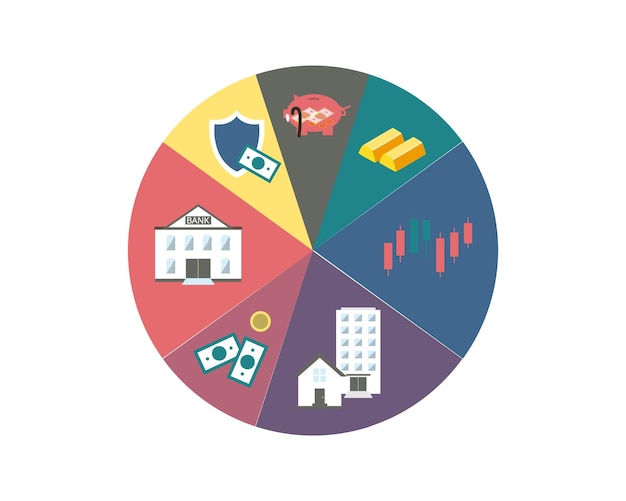Inflation 2025: Fixed-Income Investment Strategies

Anúncios
What Does the Projected 2.5% Inflation Rate for 2025 Mean for Your Fixed-Income Investments? A projected 2.5% inflation rate for 2025 suggests a stable economic environment, which may impact fixed-income investments by influencing bond yields and real returns; investors need to adjust their strategies to align with these conditions for optimal performance.
Navigating the financial landscape requires understanding economic indicators, especially concerning your investments. What Does the Projected 2.5% Inflation Rate for 2025 Mean for Your Fixed-Income Investments? It’s time to explore how this forecast could affect returns in the coming years.
Anúncios
Understanding the 2025 Inflation Projection
The projected 2.5% inflation rate for 2025 is an important benchmark for investors, particularly those in fixed-income markets. What exactly does this projection mean, and how is it determined? Let’s delve into the details.
What is Inflation?
Inflation is the rate at which the general level of prices for goods and services is rising, and subsequently, purchasing power is falling. It’s typically expressed as a percentage increase over a set period, such as a year. Moderate inflation is often seen as a sign of a healthy economy, whereas high inflation can erode the value of savings and investments.
Anúncios
How is Inflation Measured?
In the United States, the Consumer Price Index (CPI) is the most widely used measure of inflation. The CPI tracks the prices of a basket of goods and services that represent the average American household’s spending. The Bureau of Labor Statistics (BLS) releases CPI data monthly, providing insights into current inflation trends.
- CPI Calculation: Understand how the Consumer Price Index is calculated and what goods and services it includes.
- Data Sources: The key data sources used to project future inflation rates.
- Revisions: How projections are revised as new data becomes available.
Understanding the basis of inflation projections helps investors make informed decisions about their fixed-income portfolios. Knowledge of what the 2.5% figure represents will guide your investment approach for the year.
The Impact of Inflation on Fixed-Income Securities
Fixed-income securities, such as bonds, are particularly sensitive to inflation. Understanding how inflation affects these assets is crucial for managing your investment strategy. Here’s a breakdown of what you need to know.

Inflation erodes the real value of fixed-income investments because it reduces the purchasing power of future interest payments and principal. Bond yields can partially offset this effect, but not always.
Bond Yields and Inflation
Bond yields generally move in the same direction as inflation. When inflation is expected to rise, bond yields tend to increase to compensate investors for the higher inflation risk. Conversely, when inflation is expected to fall, yields tend to decrease.
Real vs. Nominal Returns
The nominal return is the stated interest rate on a bond, while the real return is the nominal return minus the inflation rate. To maintain purchasing power, your investments need to generate a real return that is at least equal to the inflation rate.
- Inflation-Adjusted Returns: Adjust your portfolio to account for real returns after inflation.
- Duration Management: Understand how bond duration impacts sensitivity to interest rate changes.
- Yield Curves: How different parts of the yield curve respond to inflation expectations.
The impact of inflation on fixed-income securities can be mitigated through strategic portfolio management. Understanding real versus nominal returns is essential for ensuring your investments keep pace with inflation.
Strategies for Fixed-Income Investors in a 2.5% Inflation Environment
Given a projected inflation rate of 2.5% in 2025, it’s important to consider strategies that can help you protect and grow your fixed-income portfolio. Here are some tactics that investors can employ:
Diversification
Diversifying your fixed-income portfolio can help reduce risk. This means investing in different types of bonds with varying maturities, credit ratings, and issuers. Diversification can provide more stable returns and lessen the impact of any single investment performing poorly.
Treasury Inflation-Protected Securities (TIPS)
TIPS are designed to protect investors from inflation. The principal of TIPS increases with inflation and decreases with deflation, as measured by the CPI. When the TIPS mature, you are paid the adjusted principal or the original principal, whichever is greater. TIPS can be a valuable tool for maintaining purchasing power, even in a moderate inflation environment.

- TIPS Laddering: Set up a ladder of TIPS to provide staggered maturity dates and manage interest rate risk.
- High-Yield Bonds: Assess the potential for higher yields from corporate bonds, considering credit risk.
- International Bonds: Consider adding international bonds to diversify geographically and tap into different inflation environments.
Investors should consider strategies like diversifying their fixed-income portfolio and utilizing inflation-protected securities to mitigate risks in a 2.5% inflationary environment.
Considerations for Different Types of Fixed-Income Investments
Not all fixed-income investments react the same way to inflation. Knowing the characteristics of different types of bonds will help you tailor your portfolio to meet your specific needs and risk tolerance.
Government Bonds
Government bonds, such as U.S. Treasury bonds, are considered to be low-risk investments. While they offer lower yields compared to corporate bonds, they provide stability in times of economic uncertainty. Government bonds are often included in a diversified portfolio as a safe haven asset.
Corporate Bonds
Corporate bonds are issued by companies to raise capital. They typically offer higher yields than government bonds but come with greater credit risk. This means there is a higher chance that the issuer may default on its debt. Investors need to carefully evaluate the creditworthiness of the issuing company before investing in corporate bonds.
Municipal Bonds
Municipal bonds are issued by state and local governments to finance public projects. The interest income from municipal bonds is often exempt from federal, state, and local taxes, making them an attractive option for high-income investors. However, municipal bonds can also be affected by economic conditions and the financial health of the issuing government.
- Tax Implications: Understanding the tax advantages of municipal bonds.
- Credit Ratings: How to interpret credit ratings for corporate and municipal bonds.
- Maturity Dates: Tailoring bond portfolios by considering various maturity dates.
Different fixed-income investments carry unique benefits and risks, requiring investors to carefully consider their investment objectives and risk tolerance when constructing a portfolio for an era of moderate inflation.
Adjusting Your Investment Timeline
Your investment timeline significantly impacts how you should approach fixed-income investments in a 2.5% inflation environment. Whether you are investing for the short-term or long-term, understanding the implications of inflation is critical.
Short-Term Investments
If you have a short-term investment horizon, such as less than five years, your primary goal should be to preserve capital while generating some income. Short-term bonds and certificates of deposit (CDs) may be suitable for this purpose. These investments typically offer lower yields but are less sensitive to interest rate changes.
Long-Term Investments
For long-term investments, such as retirement savings, you have more flexibility to take on risk in exchange for higher potential returns. Consider blending fixed-income investments with other asset classes, such as stocks and real estate, to diversify your portfolio and potentially outpace inflation.
Rebalancing Your Portfolio
Regularly rebalancing your portfolio is crucial for maintaining your desired asset allocation. This involves selling assets that have outperformed and buying assets that have underperformed to bring your portfolio back into balance. Rebalancing helps to ensure that your portfolio remains aligned with your risk tolerance and investment goals.
- Risk Tolerance: How to reassess your risk tolerance as you approach retirement.
- Asset Allocation Models: Review model portfolios designed for various life stages.
- Tax-Advantaged Accounts: Maximize contributions to tax-advantaged retirement accounts.
Adjusting your investment timeline and strategy based on short-term needs versus long-term goals is a crucial aspect of fixed-income investing in a moderate inflation landscape.
Monitoring Economic Indicators and Staying Informed
Staying informed about economic indicators and market trends is essential for managing your fixed-income investments effectively. Regular monitoring allows you to make timely adjustments to your portfolio in response to changing economic conditions.
Key Economic Indicators
Keep an eye on key economic indicators, such as the CPI, GDP growth, unemployment rate, and Federal Reserve policy announcements. These indicators can provide valuable insights into the direction of inflation and interest rates.
Following Financial News
Stay updated on financial news and market commentary from reputable sources. This can help you understand current market sentiment and potential risks and opportunities. Pay attention to the views of economists and investment strategists who specialize in fixed-income markets.
Professional Advice
Consider working with a financial advisor who can provide personalized guidance based on your specific circumstances. A financial advisor can help you assess your risk tolerance, develop an investment strategy, and monitor your portfolio on an ongoing basis.
- Financial Advisors: How to choose a qualified financial advisor.
- Market Analysis Tools: Utilize tools for tracking economic indicators and investment performance.
- Educational Resources: Stay educated using various financial literacy resources.
Being proactive and informed about economic trends allows investors to stay vigilant and make necessary adjustments in their investment strategy, ultimately protecting and potentially growing their fixed-income assets.
| Key Point | Brief Description |
|---|---|
| 📊 Inflation Measurement | CPI tracks price changes in a basket of goods and services. |
| 💡 Real Return | Nominal return minus inflation rate helps maintain purchasing power. |
| 🛡️ TIPS | Treasury Inflation-Protected Securities adjust to inflation changes. |
| 🧭 Diversification | Mix bond types to reduce risk and stabilize returns. |
Frequently Asked Questions
▼
Inflation reduces the purchasing power of future bond payments. This lowers the real return on your investment, meaning your returns buy less over time due to higher prices.
▼
TIPS (Treasury Inflation-Protected Securities) are bonds whose principal adjusts with inflation, protecting your investment’s real value by maintaining its purchasing power during inflation.
▼
Yes, diversification spreads risk across various bond types like government, corporate, and municipal, which can help stabilize returns and mitigate losses from any single underperforming asset.
▼
Rebalancing should occur at least annually, or more frequently if market conditions cause significant shifts in your asset allocations, ensuring alignment with your risk tolerance and goals.
▼
Staying informed allows for timely adjustments to your portfolio based on trends like inflation and interest rates, helping manage risks and capture opportunities proactively, based on economic context.
Conclusion
Understanding the implications of a projected 2.5% inflation rate for 2025 on your fixed-income investments is crucial for maintaining and growing your wealth. By diversifying your portfolio, considering inflation-protected securities, and staying informed about economic indicators, you can navigate the financial landscape effectively. Remember to regularly review and adjust your strategy to align with your investment goals and risk tolerance.





